▼ Greatest coral die-off in Australia: Two - third of Great Barrier Reef dead [11-30-16]
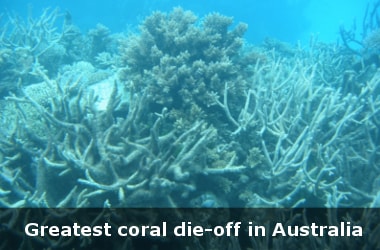 High temperature of seas around Australia's Great Barrier Reef have killed two-thirds of a 700-km (435 miles) stretch of coral in the past nine months. High temperature of seas around Australia's Great Barrier Reef have killed two-thirds of a 700-km (435 miles) stretch of coral in the past nine months.
This is the worst die-off ever recorded on the World Heritage site, scientists who surveyed the reef said on 29th Nov.
Their finding of the die-off in the reef's north is a major blow for tourism at reef which, according to a 2013 Deloitte Access Economics report, attracts about A$5.2 billion ($3.9 billion) in spending each year.
He said the die-off was "almost certainly" the largest ever recorded anywhere because of the size of the Barrier Reef, which at 348,000 sq km (134,400 sq miles) is the biggest coral reef in the world.
Coral Bleaching
- Occurs when the water is too warm.
- Coral expels living algae, causing it to calcify and turn white.
- Mildly bleached coral may recover.
- Coral mortality was lower in southern parts of Great Barrier reef.
- Australia is currently the largest carbon emitter per capita in the Pacific region.
|
▼ Lophelia pertusa: Cold water coral under climate change threat [11-29-16]
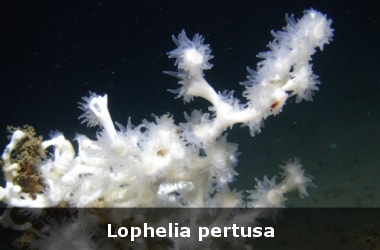 North Atlantic coral populations supporting a wide variety of sea like are under threat from climate change. North Atlantic coral populations supporting a wide variety of sea like are under threat from climate change.
Scientists have warned that changing winter weather conditions may upset fragile marine ecosystems.
Corals permit diverse forms of marine life to thrive by building reef structures that provide protection from predators and safe spaces to reproduce.
A cold water coral called Lophelia pertusa was studied. It grows in deep waters, creating elaborate reefs that are biodiversity hotspots. These populations are maintained by tiny, fragile coral larvae that drift and swim on ocean currents, travelling hundreds of miles between reefs where they attach and begin to grow.
Researchers used computer models to simulate the migration of larvae across vast stretches of ocean.
They wanted to know effect that weather changes could have on the long-term survival of Lophelia pertusa populations in the North Atlantic.
They found the shift in average winter conditions in Western Europe - one of the predicted impacts of climate change - could threaten coral populations.
The team found Scotland's network of Marine Protected Areas (MPAs) appears to be weakly connected, making it vulnerable to the effects of climate change.
A coral population on Rosemary Bank seamount, an undersea mountain off Scotland's west coast, is key to maintaining the network.
|
▼ 29 tigers poached in 2016 [11-23-16]
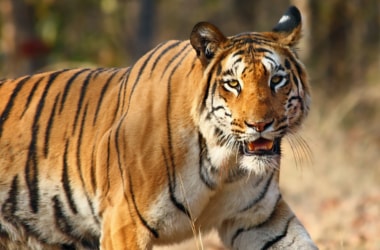 29 tigers have died in poaching activities in 2016, according to the government on 22nd Nov, while asserting several steps will be taken for steps to conserve and protect the big cats. 29 tigers have died in poaching activities in 2016, according to the government on 22nd Nov, while asserting several steps will be taken for steps to conserve and protect the big cats.
Till Nov 16, 2016, 29 tigers have died on account of poaching while 32 died of natural causes. Around 37 cases are still under scrutiny making it a total of 98.
Last year, 14 tigers died on account of poaching, while 38 died due to natural causes.
Amendment of the Wildlife Protection Act 1972 in 2006 was done.
Besides, National Tiger Conservation Authority, a Multidisciplinary Tiger and Other Endangered Species Crime Control Bureau has also been constituted.
Financial and technical help is provided to states under numerous centrally sponsored schemes including Project Tiger and the Integrated Development of Wildlife Habitats to enhance capacity and infrastructure for effective protection of wild animals.
|
▼ 2018 : Paris Agreement to get operationalised [11-21-16]
 The UN climate conference concluded on 19th Nov with negotiators from over 190 countries setting a deadline of 2018 to finalise the rule book for operationalisation of the Paris Agreement The UN climate conference concluded on 19th Nov with negotiators from over 190 countries setting a deadline of 2018 to finalise the rule book for operationalisation of the Paris Agreement
- The agreement has been on a clear roadmap to meet the deadline
- The Paris Agreement to take various climate actions by countries post 2020 to save the world from disastrous consequences of global warming, entered into force w.e.f. Nov 4
- The pre-2020 action is being covered by the Kyoto protocol of 1997 where only developed nations have to take action to reduce GHG emissions.
- Rules to implement the agreement will be framed to ensure transparency of action of all countries as per their respective pledges under the agreement adopted by 195 countries in December 2015
- Rules will specify the ways and means for measurement and accounting of emissions reductions in all nations
- They will also have a mechanism to mobilise climate finance to help the developing countries in adopting adaptation measures
- Signing of the framework agreement of the International Solar Alliance by 23 nations including Brazil, India and France during COP22 was a crucial step towards taking nations to a clean energy path
- Marrakech vision published a new document about the Climate Vulnerable Forum whereby important social justice actions for combating climate change were taken into account
- The Paris Agreement was reached after the Paris Conference on climate change which took place in December 2015 where a number of 195 countries signed the first ever binding global climate deal.
|
▼ North Pole records temperatures 20 degree C above average [11-21-16]
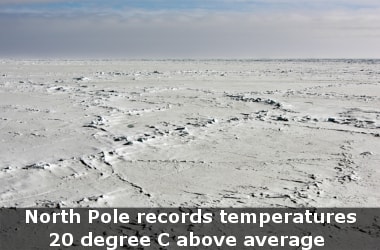 The North Pole has recorded temperatures 20 degree C (36 degree F) above average alongside a record low of sea ice for October, creating alarm for climate change scientists across the world. The North Pole has recorded temperatures 20 degree C (36 degree F) above average alongside a record low of sea ice for October, creating alarm for climate change scientists across the world.
- The polar night in the region lasts for more than 24 hours and the Arctic is supposed to get super cold
- October is the first full month when sea ice is supposed to grow; however, the ice area is 28.5 % below the 1981-2010 average
- This is the smallest since the record was begun being estimated in the late 1970s
- NOAA has declared October the third warmest on record in 2016 after 2014 and 2015
- The Arctic has been more warm for a long period of time
- Parts of Greenland including the top of Greenland’s ice sheet was 7 degree C warmer than the average the previous month, and there has also been rise in temperature on Alaska’s north slope
|
▼ Maharashtra - First state with a Fly Ash Utilisation Policy [11-17-16]
 Maharashtra on 15th Nov 2016 became the first Indian state to adopt the Fly Ash utilisation policy Maharashtra on 15th Nov 2016 became the first Indian state to adopt the Fly Ash utilisation policy
- This will pave the way for prosperity by creating wealth from waste and foster environment protection
- Decision was taken to implement the policy after cabinet approval at a meeting chaired by CM Devendra Fadnavis
- As per the policy, 100 percent of the fly ash generated from thermal power plants and biogas plants will be used for construction activities
- The fly will be utilised for making cement, wall panels, blocks, tiles, bricks and other construction materials
- The policy allows usage of fly ash within 300 km of the power plant, It was earlier to be used within 100 km radius
- Policy will create employment opportunities in power plant areas
- It will also ensure raw material is available for low cost construction to help Housing for All Projects
- Fly ash is a by product of coal combustion; it is composed of fine particles that are driven out of the boiler with the flue gases
- In modern coal fired power plants, fly ash is captured through electrostatic precipitators or other particle filtration equipment before the flue gases reach the chimneys
- Fly ash includes substantial amounts of silicon dioxide, aluminium oxide and calcium oxide
- Fly ash can be rescued as a substitute material for Portland cement and sand used in concrete production
- It can also be used for road construction.
- Agricultural uses include soil amendment fertiliser, cattle feeders and soil stabilisation in stock feed yards
- It can also be used as a substitute material for clay for cement clinkers production
- Heavy metals can leach from stored fly ash into groundwater, which can put the health of the surrounding populations in danger
- Apart from causing air pollution, it can also contaminate water and soil systems>.
|
▼ Modi’s International Solar Alliance shines! [11-16-16]
 The International Solar Alliance conceived by PM Narendra Modi will move to the next level where more than 20 countries, including India, France and Brazil have signed the framework agreement on 15th Nov- the first day when it opened for signature on sidelines of UN COP22 The International Solar Alliance conceived by PM Narendra Modi will move to the next level where more than 20 countries, including India, France and Brazil have signed the framework agreement on 15th Nov- the first day when it opened for signature on sidelines of UN COP22
- More countries are expected to join in coming weeks
- ISA is collective voice of sunshine rich nations and it will enter into force once 15 countries ratify it after completing the respective domestic processes
- This will help these countries to get low cost finance and technology to boost solar energy
- ISA was launched in COP21 on Nov 30 2015 by PM Modi and French President Francois Hollande after the former gave a call for solar resource rich nations to create a coalition to address energy needs by tapping solar energy from the sun
- Alliance provides platform for 121 prospective member nations to collaborate and address gaps through common approach
- ISA activities are increasing and with the legal framework in place, Alliance will be a major international body headquartered in India
- Alliance will create common buyers' market for solar finance, technology, innovation and capacity building will lead to higher quality and lower cost products, according to India’s environment minister Anil Madhav Dave
- Alliance will renew the objective of the Paris agreement emphasising the move towards renewable energy
- Alliance has been envisioned as a dedicated platform which will utilise and promote solar energy and solar applications to help the world transition to low carbon and greener society
- To aggregate demand, improve quality and reduce cost of solar energy in developing countries, ISA will benefit from this agreement
- The ISA aims to address energy needs by tapping solar energy from the sunInterim secretariat of the alliance is Surya Bhawan, National Institute of Solar Energy, Gurgaon
|
▼ NGT’s air pollution control suggestions! [11-14-16]
 National Green Tribunal has indicated on 10th Nov that when air pollution reaches severe levels, Delhi and neighbouring states will have to take the following measures: National Green Tribunal has indicated on 10th Nov that when air pollution reaches severe levels, Delhi and neighbouring states will have to take the following measures:
- Sprinkling water from choppers
- Stopping construction activities
- Shutting down polluting power plants and gen-sets
- Passing a host of directions to tackling air pollution in Delhi and neighbouring states, the NGT also asked for the setting up of central and 5 state-level monitoring committee to check implementation of orders and form action plans to check pollution
- When PM 2.5 and PM 10 levels cross 251 and 431 micrograms cubic metre, it is an environment emergent said the NGT chairperson Swantanter Kumar
- The chairperson also said measures would have to be implemented to tackle the situation
- Farmers must be given happy seeders-machines that sow wheat without burning paddy residues
- This is to prevent crop fires.
- During the period of severe air pollution, all construction, transport of construction material and stone crushing activities must be stopped
- States will have to shut down power plants, hot-mixers, brick kilns, diesel generator sets whose emissions are above the prescribed limit, according to an interim order for NGT
- The NGT also asked 4 neighbouring states of Delhi- Haryana, Punjab, UP and Rajasthan- to consider banning diesel vehicles older than 10 years while directing Delhi to ensure strict implementation of orders on diesel vehicles.
- Tribunal also asked Delhi government why they did not install air filters in schools for children as instructed
|
▼ India’s first LNG bus launched in Kerala [11-11-16]
 India’s first Liquified Natural Gas driven bus was launched on 8th Nov 2016 in Kerala. India’s first Liquified Natural Gas driven bus was launched on 8th Nov 2016 in Kerala.
- Union Petroleum and Natural Gas Minister Dharmendra Pradhan and Kerala CM Pinarayi Vijayan flagged off the bus.
- The LNG driven bus was rolled out of Union Government plans to use LNG.
- Liquified Natural Gas is a natural gas with methane and ethane and it has been converted to liquid form for easy storage or transport.
- It takes up 1/600th the volume of the natural gas in the gaseous state.
- It is odourless, colourless, toxic and non corrosive.
- LNG achieves a higher reduction in volume as against CNG so volumetric energy density of KNG is 2.4 times that of CNG or 60 percent of the diesel fuel.
- This ensures that LNG is cost efficient to transport over long distances where pipelines are not prevalent.
- Natural gas has the lowest CO2 emissions per unit of energy.
- Burning natural gas produces 30 percent less CO2 than burning petroleum and about 45 percent less than burning coal.
|
▼ Uttarakhand HC orders hill stations and glaciers to be declared eco sensitive [11-10-16]
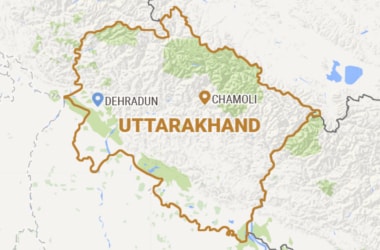 Uttarakhand High Court has ordered all hill stations and glaciers in the state to be declared as eco-sensitive within three months and put a ban on all construction within 25 km radius of the glaciers. Uttarakhand High Court has ordered all hill stations and glaciers in the state to be declared as eco-sensitive within three months and put a ban on all construction within 25 km radius of the glaciers.
- It also directed nagar panchayats and municipal boards across the Ganges and Yamuna to set up sewage treatment plants within 6 months and asked government to check water quality every day.
- HC also banned construction and felling of trees within 2 and 5 km across the lakes of Bhimtal, Sattal, Naukuchyattaal, Nainital and Khurpatal.
- No new construction will take place within 25 km of Gangotri and Yamunotri glaciers and no fossil fuel will be burnt within radius of 10 km around them.
- Uttarakhand earlier known as Uttaranchal referred to as Land of the Gods is a global pilgrimage centre and contains many Hindu temples.
- It was created on 9th Nov 2000.
- Its official languages are Hindi and Sanskrit and Kumaoni as well as Garhwali languages are also heard here.
- Capital city and largest city is Dehradun.
|
▼ River Chandrabhaga actually existed! [11-8-16]
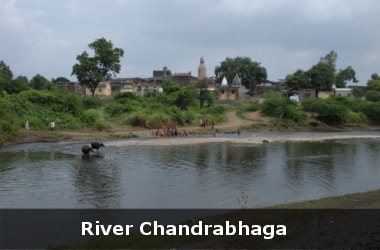 The ancient river is said to have flowed around 2 km from the Konark Sun Temple in Odisha, a UNESCO World Heritage site built by King Narasimhadeva 1 of Eastern Ganga Dynasty in 1255 CE. The ancient river is said to have flowed around 2 km from the Konark Sun Temple in Odisha, a UNESCO World Heritage site built by King Narasimhadeva 1 of Eastern Ganga Dynasty in 1255 CE.
- The river holds an important position in ancient Indian literature.
- Mythical stories around Konark include pictorial presentations such as palm-leaf drawings, sketches and old photographs indicate its presence close to the temple.
- Other than the mentions, there is no visible trace of the river around the temple.
- Scientists analysed satellite data using images from US satellites Landsat and Terra and from the NASA Space Shuttle Endeavour Radar Technology Mission in 2000.
- Satellite imagery plus images from Google Earth have been used to show a sinusoidal trace characteristic of typical palaeochannel passing north of the Sun temple, extending approximately parallel to the coast.
- The term effectively means remains of an inactive stream/river that has been filled or buried by younger sediment.
- Field analysis shows the palaeochannel is associated with swampy lands covered with water hyacinth plants.
- Surface profiling using ground penetrating radar further confirmed its existence as it shows the existence of the V-shaped subsurface river valley.
- It can be traced till Tikarpada village, near banks of Kadua River.
- A geological map shows heavy alluvium deposits in the area which is characteristic of rivers.
- Numerous patches of water bodies have been seen in various locations along the channel and swampy areas believed to be part of the ancient river.
- These have been reserved by the Odisha government for the holy bath during Magha Saptami.
- Demarcations of pockets of freshwater zones within the dominantly saline water environment and a rise in drinking water concerns across the Odisha coast have been indicated as a result of this finding.
|
▼ Team to conserve Loktak Lake in Manipur [11-8-16]
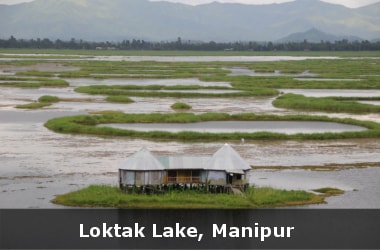 The Ministry of Environment, Forest and Climate Change on 4th Nov 2016 constituted a 4 member team for conservation and management of Loktak Lake in Manipur. The Ministry of Environment, Forest and Climate Change on 4th Nov 2016 constituted a 4 member team for conservation and management of Loktak Lake in Manipur.
- The lake will be visited from 7-9 November 2016 and discussions will also be held by the state government, concerned agencies and other stakeholders.
- Consultations will also include people living in the vicinity of the lake.
- The ministry has asked the team to submit a report by 15th Nov 2016.
- The team will review the implementation of work conducted with monetary assistance provided by the Centre and the State for the conservation and management of Loktak Lake.
- Further interventions are also needed for conserving the lake in a holistic way.
- Loktak Lake will also aim for UNESCO World Heritage Site status.
- Steps and actions will be taken to increase the tourism protection of this lake.
- Loktak Lake is the largest freshwater lake in NE India.
- It is famous for the phumdis or heterogenous mass of vegetation, soil and organic matter at numerous stages of decomposition floating over it.
- The largest of the phumdis covers 40 km2 or 15 square miles and is situated in the SE shore of the lake.
- Ancient Loktak lake plays an important role in the economy of Manipur and serves as a source of water for generation of hydropower as well as irrigation and drinking water supply.
|
▼ Natural snowballs on Gulf of Ob in NW Siberia [11-7-16]
 Thousands of natural snowballs were formed on the 18-km stretch of the beach in the Gulf of Ob in NW Siberia creating a mystery. Thousands of natural snowballs were formed on the 18-km stretch of the beach in the Gulf of Ob in NW Siberia creating a mystery.
- A part of the coast was covered by icy spheres.
- Sculptural shapes range from the size of a tennis ball to 1 metre across.
- This results from are environmental processes where small pieces of ice form are rolled by wind and water and end up as giant snowballs.
- Locals in Nyda lying on the Yamal Peninsula above the Arctic Circle found this phenomenon to be unique.
- This is a primary natural phenomenon-sludge ice, slip ice.
- The combination of the effects of the wind, the lay of the coastline and the temperature and wind conditions add to this.
|
▼ Number of big cats in Sunderbans rising! [11-7-16]
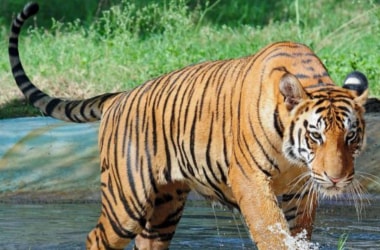 Number of big cats in the Indian Sunderbans is healthy and rising. Number of big cats in the Indian Sunderbans is healthy and rising.
- A fresh camera trap has spotted 9 more tigers over the last year’s figures in the entire mangroves, including the tiger reserve area and the South-24 Parganas forest division.
- The assessment exercise by the MoEF and WII has put India in 2015 as having the total tiger count in the Sunderbans at 76.
- State foresters have put the number at more than 85 on the basis of camera trap images.
- This indicates the largest mangrove forest in the world spanning two countries, the Sunderbans is reviving.
- Camera trap images were analysed with the help of special software matching the stripe pattern of big cats to arrive at the figure of 85.
- Recent sighting has shown the population inside the STR is healthy.
- Camera trap exercise was started in December 2015 in the South 24 Parganas forest division as completed in April 2016.
|
▼ Paris Agreement enters into force on Nov 4, 2016 [11-7-16]
 The Paris Agreement has entered into force on Nov 4, 2016. The Paris Agreement has entered into force on Nov 4, 2016.
- The agreement involves GHG emissions mitigation, adaptation and finance.
- Paris Agreement’s entry into force comes after countries representing 55 percent of the world’s emissions joined the deal.
- As per Nov 2016, 192 states have signed the agreement.
- The EU is also a signatory to the agreement.
- 97 of these parties have ratified or accepted the agreement.
- Notable among these are the leading GHG emitters China, the US and India.
- The Paris Agreement is inked within the United Nations Framework Convention on Climate Change.
- Language of the agreement was negotiated by 195 nations at the 21st COP of the UNFCC in Paris.
- It was adopted by consensus on 12th December 2015.
- It was launched for the signatories on 22nd April 2016 in NYC.
- The EU ratified the agreement in Oct 2016.
- The agreement has come into force due to ratification by enough countries.
- The prime aim of the protocol is to limit global average temperature to well below 2 degree C above pre-industrial levels.
- COP has established a global goal on adaptation of enhancing adaptive capacity, strengthening resilience and lowering vulnerability to climate change.
- Averting, minimising and coping with losses due to climate change is another mitigation based goal.
Other aspects of the agreement focus on:- Technology Transfer
- Capacity Building
- Financing
- Implementation
- Review
|
▼ Warming ocean & atmosphere in the Arctic affect Sea Ice Cap! [11-1-16]
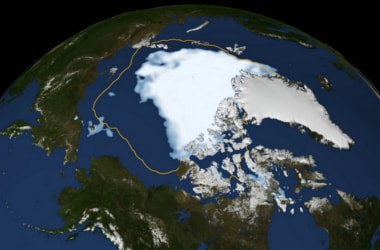 As the extent of the Arctic Sea Ice, a vast sheath of frozen seawater floating on the Arctic Ocean and the neighbouring seas, shrinks, its oldest and thicker ice has either thinned or melted away, ensuring that the sea ice cap is more vulnerable to the warmed oceans and atmosphere. As the extent of the Arctic Sea Ice, a vast sheath of frozen seawater floating on the Arctic Ocean and the neighbouring seas, shrinks, its oldest and thicker ice has either thinned or melted away, ensuring that the sea ice cap is more vulnerable to the warmed oceans and atmosphere.
- The older ice is disappearing; scientists have likened it to the bulwark of sea ice. A warm summer melts the thin and young ice, but it cannot ensure the end of the older ice.
- The older ice is is weaker as there is less of it and the remaining old ice is broken up and thinner, so the bulwark is not as good as it was previously.
- Direct measurements of sea ice thickness are sporadic and incomplete across the Arctic so scientists have developed sea ice age estimates and tracked their evolution from 1984 to current times.
- A new NASA visualisation of the age of the Arctic Sea Ice shows how sea ice has been undergoing growth and shrinking, spinning, melting in place and drifting out of the Arctic for the past 30 years.
- The old sea ice is melting within the Arctic Ocean during the summertime and this is because the multiyear ice would be considered an ice pack and now small chinks of old ice are interspersed with the new ones.
- Most of the older ice has been lost; in the 1980s, multiyear ice made up 20 percent of the sea ice cover; now it is only about three percent.
- Older ice was the safety net of the Arctic sea ice pack and as it is lost, the likelihood for an ice free summer in the Arctic increases.
|
▼ World’s largest marine park formed in Ross Sea! [11-1-16]
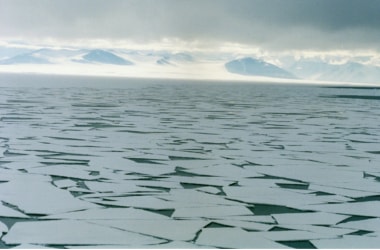 A landmark global agreement has created the world’s largest marine park in the Southern Ocean has been brokered in Australia, following five years of compromises and failed negotiations. A landmark global agreement has created the world’s largest marine park in the Southern Ocean has been brokered in Australia, following five years of compromises and failed negotiations.
- More than 1.5 sq km of the Ross Sea around Antarctica will be protected under the deal brokered between 24 nations and the EU.
- It means 1.1 sq km of it– an area around the size of France and Spain combined– will be set aside as a no-take general protection zone where no fishing is permitted.
- The protections are set to expire in 35 years.
- Agreement came towards the end of 2 weeks of discussion between delegates from 24 countries and EU in Hobart at the annual Commission for the Conservation of Antarctic Marine Living Resources.
- This is also the first marine park created in global waters and will set a precedent for further moves to help the world attain the IUCN’s recommendations that 30 percent of the world’s oceans have to be protected.
- The Antarctic protection has been sought because of the vital importance of the Southern Ocean to the world’s natural resources.
- Scientists have estimated that the Southern Ocean produces 3/4th of the nutrients that sustain life in the remaining oceans of the world.
- The region is home to many of the world’s penguin and whales.
- Ross Sea is a deep bay in the Southern Ocean many have considered the intact marine ecosystem on Earth.
- This is a living lab ideally suited for studying the life in the Antarctic and how climate change affects Earth.
|
▼ Birds that fly for 10 months without ever landing! [11-1-16]
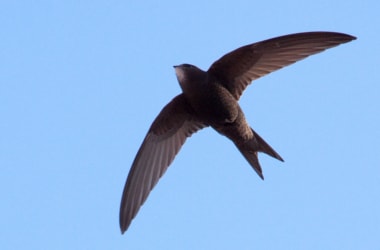 A small, dark feathered bird called the common swift flies for 10 months on end without ever landing. A small, dark feathered bird called the common swift flies for 10 months on end without ever landing.
- This marks the longest time spent aloft of any known bird.
- The findings reported by scientists confirm the 46 year old hypothesis first offered by British researcher Ron Lockley.
- The research had theorised that the birds spent most of their lives in air.
- Tiny backpacks were fitted on 13 of the brownish black birds, weighing only one gram.
- These micro data logs recorded whether birds were in the air or not, their acceleration and where they had been given at any time.
- When the common swifts leave their breeding site for migration to Central African forests via West Africa, they never touch the ground till they retire for the next breeding season 10 months following this.
- While some birds may roost for brief periods or spend entire nights in mid-winter resting, others never landed during the period.
- For those who did stop, it was done briefly and close to 99.5 percent of the 10 months were spent in air.
The birds catch food while in flight. - They may also sleep when flying to high altitudes form dawn to dusk and slowly descend.
- During the day, energy is saved by gliding in the upward currents of warm air.
- This discovery pushes boundaries for animal physiology.
- A 10 month flight phase is the longest of any bird species and it’s a record.
- Other kinds of birds such as frigate birds are known to sleep while gliding.
|
| Chronology of events |
|
As per the Paris Agreement on Climate Change that officially entered into force on Nov 4, 2016, USD 100 billion was raised by developed countries to finance climate change mitigation projects by 2020.
|
|
Asia’s largest man-made Jungle Safari is located in Chhattisgarh.
|
|
Indian Railways has set the target to attain 100 percent decarbonisation with 90 percent electrification.
|
|
India has recorded the highest number of seizure of tigers and parts among all 13 tiger range countries, accounting for 44 per cent, according to a report by wildlife trade monitor released 16th Nov 2016
|
|
More than 20 countries signed the framework agreement of the ISA at Morocco’s Marrakech; the ISA was first proposed by Indian PM Narendra Modi
|
|
India was ranked 20 in the Climate Change Performance Index 2017 released by Germanwatch and Climate Action Network Europe
|
|
Ninety percent of projects got environmental clearance in the country last year as compared to nearly 54% in 2014, according to Environment Minister Anil Madhav Dave.
|